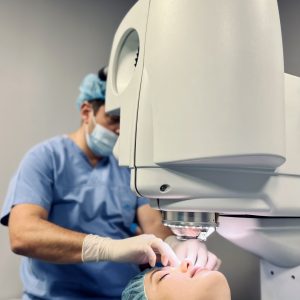What Is a Refractive Error?
Refractive error means that the shape of your eye does not bend light correctly, resulting in a blurred image. The main types of refractive errors are myopia (nearsightedness), hyperopia (farsightedness), presbyopia (loss of near vision with age), and astigmatism.
The causes of the main types of refractive error are described below:
Astigmatism Astigmatism usually occurs when the front surface of the eye, the cornea, has an asymmetric curvature. Normally the cornea is smooth and equally curved in all directions, and light entering the cornea is focused equally on all planes, or in all directions. In astigmatism, the front surface of the cornea is curved more in one direction than in another. This abnormality may result in vision that is much like looking into a distorted, wavy mirror. Usually, astigmatism causes blurred vision at all distances.



Laser Refractive Surgery
Laser vision correction refers to procedures performed by laser corneal remodeling (transparent front part of the eye) with the purpose of decreasing or increasing the diopter value, eliminating optical aids, and improving visual acuity. Today there are several methods of vision correction, and the basic division is based on the depth of the cornea at which the operation is performed (middle of the cornea – Femto-LASIK and the surface of the cornea – PRK/LASEK).
LASIK (Laser in Situ Keratomileusis) is the most commonly performed type of surgery for vision correction. LASIK is the most common choice of surgeons due to its high accuracy, excellent and long-term stable postoperative results, the complete absence of pain (both during the surgery and in the postoperative period) and a very rare occurrence of complications.
LASIK procedure is a two-step operation. The first step is the forming of the flap (on the cornea), and the second is the remodeling of the corneal surface using excimer laser. The flap on the cornea can be formed in two ways:
Femto – LASIK (Synonyms: ALL – Laser LASIK, Bladeless LASIK, iLASIK, Z-LASIK).
Indications for surgery are diopter values from -10.0 to +6.0, and up to ± 5.0 cylinders of astigmatism. This type of LASIK method is fully automated and laser-controlled, without using the knife blade. Today, the surgeries are performed in UEH on IntraLase femtosecond laser, which is also the most used femtosecond laser in the world.
Due to the precision of the incision, the flaps of the cornea have a more regular shape and more predictable thickness compared to flaps made by microkeratome. Therefore, the advantage of such method is of particular importance in higher diopter values, astigmatism, and thinner corneas It also reduces the possibility of occurrence of dry eye and enables better healing.